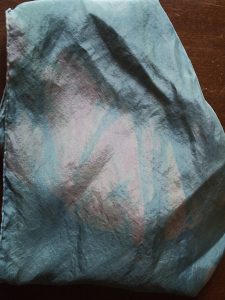Have you ever dyed a skein of yarn, only to find that the ties were too tight and you had a white line? I have, but, I’ve also deliberately naturally dyed twisted skeins to get variegated colours. The cause of the un-dyed portion is called a resist. Natural dye resists are fun, and also irresistible. Why complain about uneven dye coverage, or natural dye variation, when it can be used as a design element? This is particularly true when dying with natural indigo, or natural woad indigo.
Types of Resists for Natural Dyes
- Wax resists, also known as batik are one method of varying natural dye colours deliberately. Batik is used in India to form complex cloths. Batik can only be used with a cold water natural dye vat, because a boiling water natural dye vat would melt the wax.
- Mud resists, also known as mud cloth are a second method of changing the colour of naturally dyed fabric. The mud is applied to damp or dry cloth, after the dye, in a design. The natural dye normally contains tannin, and the mud contains iron which saddens and blackens the colour. A fairly complex design can be created using mud resists.
- Shibori is a method standardly used with natural indigo dyeing. Shibori is done by tying the fabric and then dying with indigo. After dying, the resisted areas are white, in a dark indigo background. The goal of traditional shibori is to imitate the stars, so with crisp white resists and deep dark indigos.
- Tie dye is a spoof off shibori and is done by applying different colours to tied fabric. The ties still give a white resists, but instead of being one colour, the finished item is multi coloured.
Shibori
Shibori is a personal favourite. I love dying scarves in natural indigo and seeing what crazy designs come from the resists. For Shibori resists, nearly anything can be used. From gathered running stiches to form complex, traditional designs, to clean screws, buttons, thread and elastics for a less complicated resist. Though no matter what technique is used, the results will always be unique and amazing.
Resists with more than one colour
Sometimes you just want more than plain blue, or plain yellow, how do you get it? Resists and overdyes are the answer. You can apply a resist to white fabric and then dye it with tannin (in the case of cotton it acts as an secondary mordant). When you undo the resist you have some white areas and some dyed areas. Re-doing resists with a different pattern and then dying with indigo would give you some green, yellow/tan, and blue areas. Yum, lots of natural dye colours on one piece of fabric, just waiting to be made into something lovely.
Back to You
What is your experience with resists and natural dyes? Have you ever done natural indigo dyed shibori? I would love to hear your story. Leave a comment.
